Choosing the right pot for your mini bonsai tree can be daunting. There seem to be so many things to consider like the size of the pot and shape of the pot.
In this post, I am going to share with you a guide on how to choose a pot that is perfect for your mini bonsai tree. For a tree on training, please refer to this post on bonsai training pots.
Choosing the right mini bonsai pot: five things to consider
There are 5 things to consider when choosing a bonsai pot for your tree.
- Pot size
- Pot depth
- Pot color
- Pot shape
- Tree health
To choose the right pot for your mini bonsai tree, it is important to think about whether the pot matches the bonsai aesthetics and whether the pot keeps your tree healthy. Specifically, size, depth, color, and shape should be considered with regard to bonsai aesthetics.
Bonsai pots and the bonsai aesthetics
Bonsai is the Art of Miniature Landscape: a natural landscape created with plants in a bonsai pot. So, you must choose the pot that represents the scenery that you want to create in it. The pot’s size, depth, color and shape are particularly important in this regard.
Size of the pot
In bonsai, the pots serve to represent the landscape where the trees are growing. If the pot is too large compared to the size of the tree, the bonsai will not be a reflection of nature but just a tree planted in a pot. The balance and the harmony between the style of the tree and the size of the pot are what makes a tree in a pot a bonsai.
Depth of the pot
Again, the pots serve to represent the landscape where the trees are growing;
- deep pots represent cliffs,
- medium depth pots represent hills, and
- shallow pots represent plain fields.
| Pot Depth | Nature image | Bonsai style |
| Deep | Cliff | Cascade |
| Medium | Hill | Slanting |
| Shallow | Field | – Upright – Forest |
Color of the pot
There is also a close relationship between the color and the pot in the bonsai aesthetic.
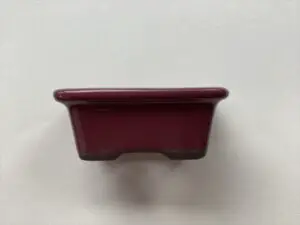
red

blue
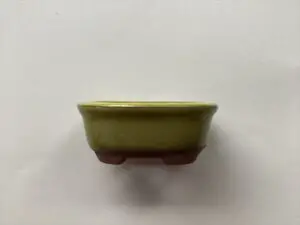
yellow
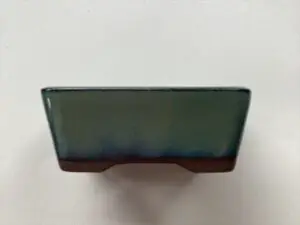
green
- The reddish color gives an intense and rough impression, representing rocky and wild land.
- The blue color is associated with water and tranquillity.
- The yellow is reminiscent of autumn leaves and the scenery of winter trees.
- The green color brings to mind summer fields.
Shape of the pot
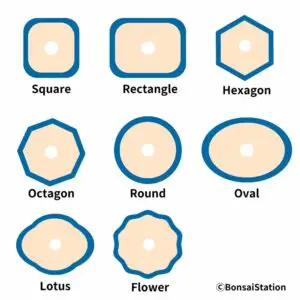
Different types of bonsai pot shape
Shape of the pot also reflects the images of nature. There are 3 major shapes in bonsai pots, i.e. square, round and others.
- Square gives a rigid, artificial and vigorous impression.
- Round is associated with abundance, harmony, tenderness and calmness.
- Other irregular shape brings to mind free, agile and restless impression.
| Pot shape | Impression | Bonsai species |
| Square | Rigid, artificial, vigorous | Coniferous |
| Round | Abundant, harmonious, tender, calm | Deciduous Flower Fruit |
| Other | Free, agile, restless | Flower Fruit |
Bonsai pots and bonsai trees’ health
The other thing, besides the aesthetic of bonsai, in choosing the right pot is bonsai trees’ health. Pots are what keep the bonsai trees alive; pots are the place for bonsai trees to absorb nutrients and water as well as to take root. Without the right pot, your bonsai tree cannot thrive well.
In this regard, there are two things to keep in mind when choosing a pot: drainage and the amount of soil the pot can contain.
Drainage
It is important for bonsai pots to have good drainage because roots need oxygen to respirate for their reparation and growth. It is true that roots suck water from the soil but they will drown and rot if they are soaked in water.
The pot’s ability to drain water depends on;
- number of drainage holes,
- depth of the pot and
- the surface material of the pot.
Number of drainage holes
Of course, the drainage of pots depends on the number and the size of the drainage holes at the bottom. Ideally, the number of drainage holes is two or more. But for a mini bonsai pot whose bottom surface is tiny, there might be a case where there can only be one drainage hole. In this case, the bigger size of the hole the better.
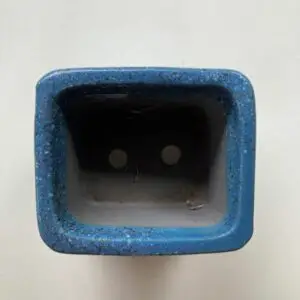
2 drainage holes
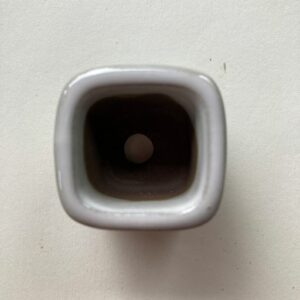
1 big drainage hole
Depth of the pot
The drainage also depends on the depth of the pot.
Contrary to popular belief, deep pots drain water well. The shallow pots in reality drain poorly. This is because the shallow pots cannot rely much on gravity to drain water, and once the water reaches the bottom of the pot, which is usually flat, water will not move to drainage holes on its own.
| Pot Depth | Characteristics |
| Deep | – Good drainage – Good aeration – Unstable |
| Medium | – Good drainage – Good water retention – Adequate soil amount |
| Shallow | – Poor drainage – Little soil |
Surface material of the pot
As to the pots’ surface, unglazed pots have better drainage than those with glaze. Thanks to its porosity, not only through the drainage holes but the water in unglazed pots can evaporate through the surface of the pot as well.

glazed pot: poor drainage
Amount of soil in the pot
It is better to have as much soil as possible for trees’ health since the roots take the nutrients and water they need from the soil. Increasing the amount of soil in the pot without increasing the overall size is the key. In other words, the pots that can contain more soil than they look are the good ones.
Choosing a thin and/or round body is a good way to satisfy this purpose.
Thin

thin: more soil
Thick

thick: less soil
Body- round
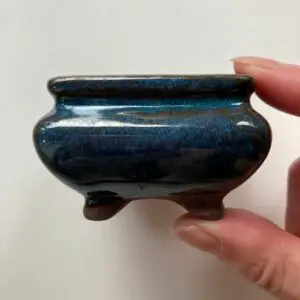
Body-round: more soil
Body- straight
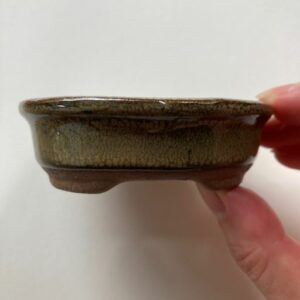
Body- straight: less soil
How to choose the size of the pot
Pot size for a bonsai tree
The right balance of the pot to a bonsai tree is 2:3, meaning if the height of the tree is 3, the widest part of the pot is 2, or if the height of the tree is 2, the widest part of the pot is 3.

pot size balance to the tree

pot size balance to the tree
Pot size for a mini bonsai tree
The size of the pot for mini bonsai trees should be a bit smaller than the normal bonsai trees. A pot that is disproportionately small compared to a tree makes a mini bonsai tree look even larger, just like the tree in the ground.
Mini maple bonsai: 5 inches
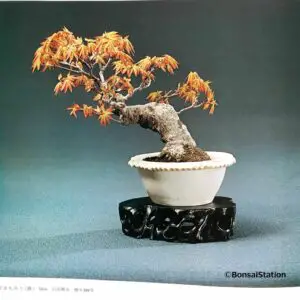
mini maple tree
Normal maple bonsai: 30 inches

normal maple bonsai
How to choose the depths of the pot

Bonsai pot depth
Roughly, there are
- shallow pots
- medium shallow pots
- medium deep pots and
- deep pots.

shallow pot
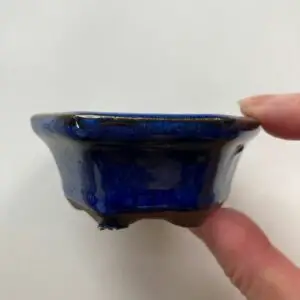
medium shallow pot

medium deep pot
Depth of the pot
As mentioned earlier in this post, the depth of the pot represents the landscape where the tree is growing. As such, there are certain types of bonsai styles that need to be potted in a certain pot depth besides just balance.
- The cascade style of bonsai represents a natural tree growing down the face of a cliff, which is represented by deep pots.
- The slanting style emulates a tree in nature which has been forced to curve by natural elements such as wind and storms. This style best matches medium deep/shallow pots, which represent a hill.
- Shallow pots represent plain fields with a tree growing straight up or a forest. So, formal/ informal upright and forest bonsai styles look good on shallow pots.
| Pot Depth | Characteristics | Nature image | Bonsai style |
| Deep | – Good drainage – Good aeration – Unstable |
Cliff | Cascade |
| Medium | – Good drainage – Good water retention – Adequate soil |
Hill | Slanting |
| Shallow | – Poor drainage – Little soil |
Field | – Upright – Forest |
How to choose the color of the pot
As a general rule, dull and neutral colors go well with any tree species or styles. Never match the color of the pot with leaves, flowers or fruits as bonsai trees will blend with the pot and do not stand out.
| Tree species | Recommended | Do nots |
| Coniferous | red, purple, brown | blue, green |
| Deciduous | blue, deep blue | red, yellow, white |
| Flower (white) | light yellow, light blue | white, deep blue |
| Flower (red/pink) | dark blue | red |
| Flower (yellow) | dark green | yellow |
| Fruit | dark blue | red |
Coniferous trees

Coniferous tree with dull brown pot
As evergreen, dull reddish colors like purple and brown pots look good for coniferous trees throughout the year.
On the other hand, dark blue looks out of balance for coniferous trees because of the strong contrast with the leaf color, and the greenish color is the matching color of the leaves and has to be avoided.
Stoneware pots with dull colors look better than shiny, glazed pots for coniferous trees.
Deciduous trees

Oak with blue pot
Blue/deep blue pots go well with deciduous trees such as maple and oak.
Never use red or yellow pots with deciduous trees because the pots’ colors match the color of the leaves in fall, and the bonsai trees blend with the pots and do not stand out. White pots look empty and too gloomy in winter after the leaves have fallen.
Flower and fruit

Azalea with a deep blue pot
For flowers and fruit trees, the basic rule is to choose the colors that complement the color of the flowers and fruits. Light yellow or light blue pots look good on white flowers like camellias and plums whereas deep blue and purple are too strong as eyes are rather drawn to the color of the pots than the white flowers.
Deep blue goes well with red camellias and azalea as colors complement each other. Dark green pots are a good reflection of the yellow flowers.
Blue pots are often good on the flowers of deciduous trees such as cherry blossoms, peaches, and wisteria.
How to choose the shape of the pot
Shapes

Different types of bonsai pot shape
There are 3 major shapes in bonsai pots:
- square
- round
- others.
Square

rectangle pot
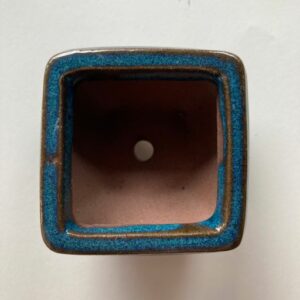
square pot

hexagon pot
Square shaped pots include rectangular, hexagonal and octagonal pots.
- Rectangle
- Square
- Hexagon
- Octagon
Round

round pot
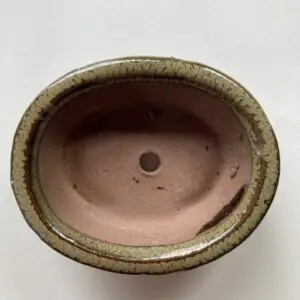
oval pot
Major circular shapes are round and oval.
- Round
- Oval
Other irregular shapes
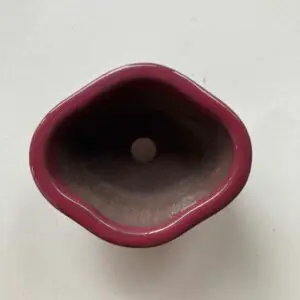
lotus pot
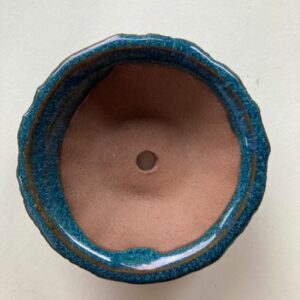
flower shape pot
Other irregular shapes include lotus and flower shapes.
- Lotus
- Flower
How to choose the shape of the pot
As a general rule, shallow round or oval pots suits any bonsai tree species and style.
Upright/slanting
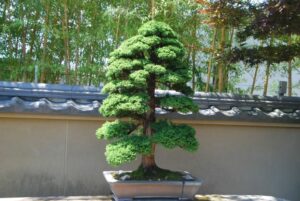
Upright style with rectangular pot
For upright and slanting style trees with thick trunks, rectangle, medium deep and thick, heavy pots suit well. If the tree is in training and the trunk is not large enough, square, shallow and thin pot goes well.
Heavy and square/rectangular pots are good for trees with a dynamic impression such as black and red pines.
Two- and three-trunks
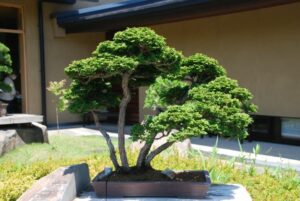
Four-trunks style with rectangular pot
For two- and three-trunks with taller/shorter and bigger/smaller trees, shallow, oval or rectangular pots blend well with the trees. Thick and deep pots make bonsai look heavy and disproportionate.
Forest
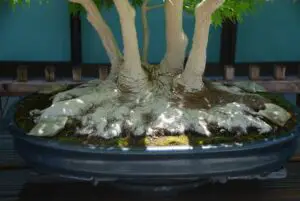
Maple forest dtyle with oval pot
For style with multiple trees like forest, shallow, round/oval or rectangular pots blend well with the trees. Thick and deep pots make the bonsai look heavy and disproportionate.
Cascade

Cascade style wit deep cascade pot
For cascade, deep round or square pots are a must for stability. Shallow pots for cascade style are disproportionate and unstable, risking the pot to fall over.
How to choose mini bonsai pot: tables
By tree species
| Shape | Depth | Color | Glazed | |
| Coniferous | Square, rectangle | Medium | Red, purple, brown | Unglazed |
| Deciduous | Oval, rectangle | Shallow, medium | Complementary | Glazed |
| Flower/Fruit | Oval, lotus, hexagon, octagon | Mid deep | Complementary | Glazed |
By tree style
| Shape | Depth | Weight | |
| Upright/slanting | Oval, rectangle | Shallow- Mid deep | Heavy |
| Two-trunk | Oval, rectangle | Shallow | Medium |
| Literati | Round, square | Shallow | Light |
| Forest | Oval, rectangle | Shallow | Light |
| Cascade | Round, square | Deep | Mid-heavy |



